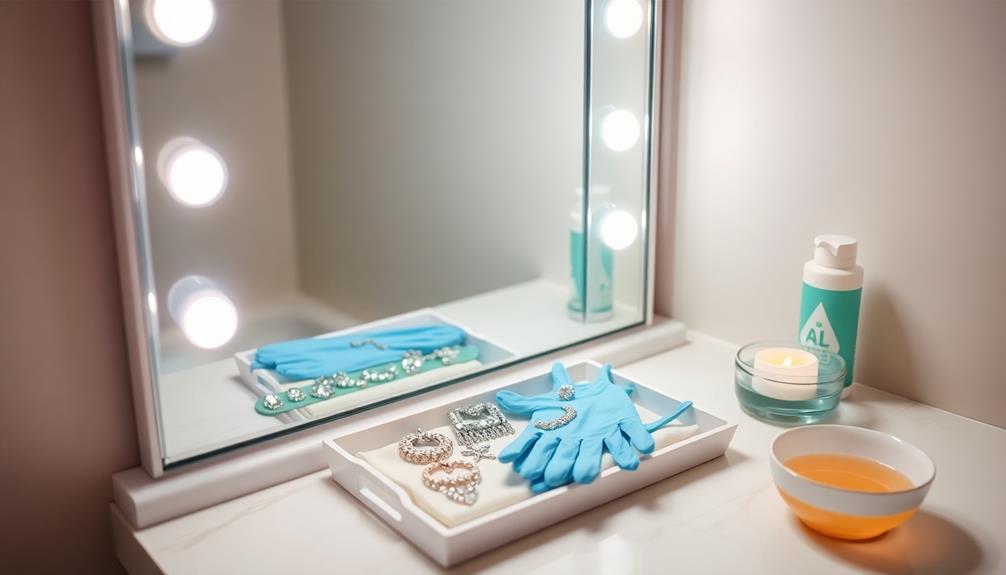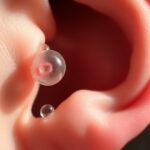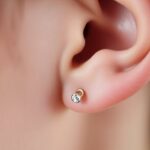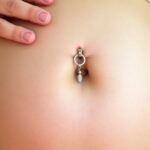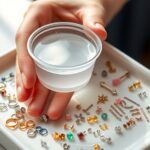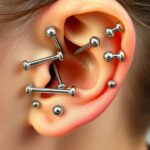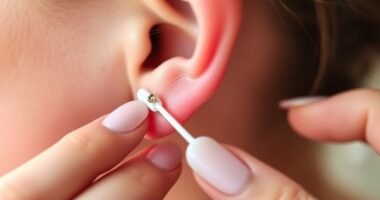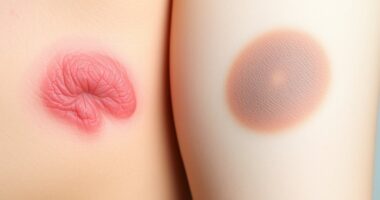To safely change your piercing jewelry at home, first verify your piercing is fully healed. Wash your hands and clean the jewelry with piercing soap. Wearing nitrile gloves can help with hygiene. Prepare your workspace by placing a towel in the sink to catch any drops. When changing jewelry, be gentle; if you feel resistance, stop and consult a professional. Choose jewelry made from hypoallergenic materials like surgical steel or titanium to prevent irritation. After changing the jewelry, monitor your piercing for any signs of discomfort, and there's more to discover about styles and maintenance to keep your piercings healthy.
Key Takeaways
- Ensure your piercing is fully healed before attempting to change jewelry to avoid irritation or complications.
- Clean your hands and jewelry thoroughly, and consider wearing nitrile gloves for better hygiene and grip.
- Familiarize yourself with the type of jewelry being changed and use proper techniques for removal and insertion.
- Verify the gauge size, diameter, and length of new jewelry to prevent sizing issues and discomfort.
- Monitor the piercing for irritation after changing jewelry and revert to the original piece if problems persist.
Preparation and Safety Guidelines
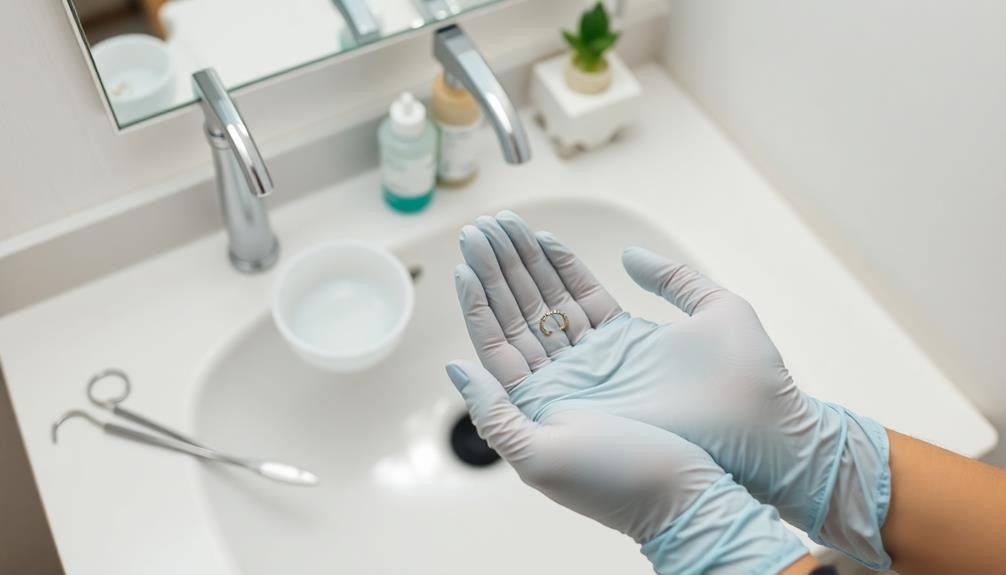
Before you change your piercing jewelry, have you confirmed your piercing is fully healed? Rushing into a jewelry change can cause irritation or even lead to complications like infection. So, proper preparation is essential.
Start by cleaning your hands thoroughly and verifying your jewelry is hygienic. Use piercing soap to clean both your hands and the jewelry to prevent any contamination.
To enhance cleanliness, consider wearing nitrile gloves during the process. This not only improves your grip but also adds an extra layer of hygiene while handling your jewelry.
It's a good idea to place a towel in the sink beforehand, too. This way, if you accidentally drop a piece, you won't lose it down the drain.
Once you've successfully changed your jewelry, pay attention to how your piercing feels. If you notice any irritation or discomfort, stop and consult a professional piercer for advice before attempting another change.
Taking these safety guidelines seriously will guarantee a smoother jewelry change experience while keeping your piercing healthy.
Understanding Jewelry Types
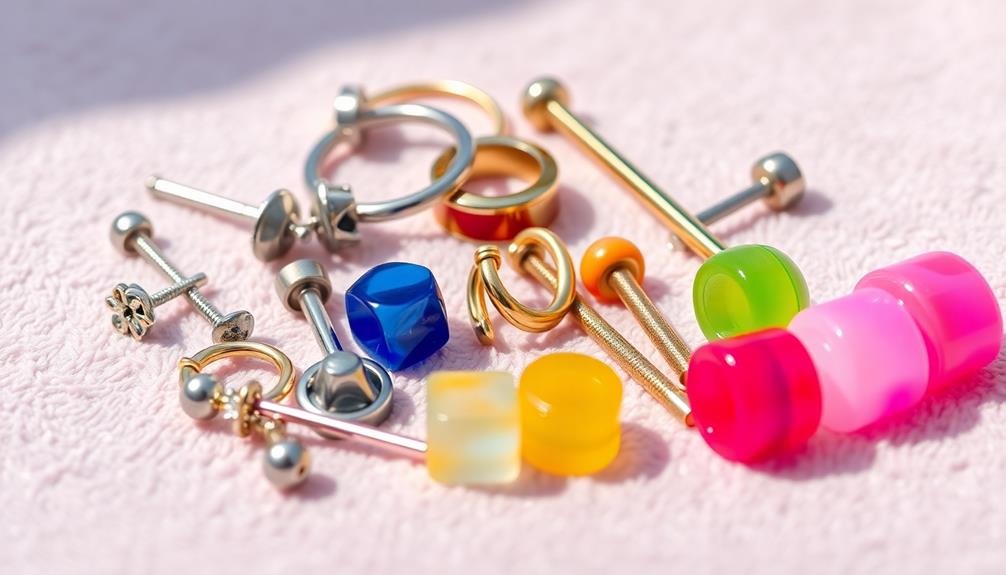
Knowing the different types of piercing jewelry can help you choose the best option for your style and comfort. There are several popular types, including barbells, labrets, hoops, and plugs, each designed for specific piercings. When you're considering changing your jewelry, it's important to select a type that suits your needs.
Internally threaded jewelry is a great choice, featuring a top that screws into a post. This design minimizes irritation during insertion, making it user-friendly.
If you're looking for something easy to wear, seamless hoops are a top pick. These hoops have a hinge mechanism, allowing you to change your jewelry quickly without compromising the hoop's shape.
Push-pin studs are another practical option, utilizing a bendable post that latches securely into place. This makes them simple to swap out decorative pieces whenever you want a new look.
Each type of piercing jewelry offers unique benefits, so consider your comfort and style preferences when making your selection. By understanding these options, you'll feel more confident and comfortable as you change your jewelry at home.
Materials for Piercing Jewelry
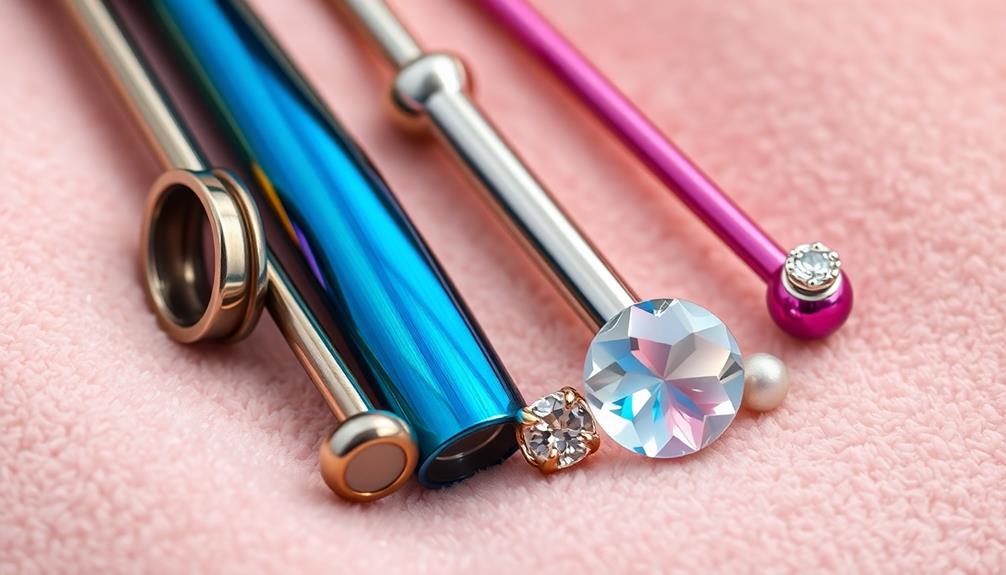
When choosing piercing jewelry, it's crucial to evaluate the materials available and their properties.
You'll want hypoallergenic options like surgical steel or titanium if you have sensitive skin, while solid gold offers both durability and elegance.
Additionally, understanding the strength of materials like brass can help you select the best fit for your piercing needs.
Jewelry Material Options
Choosing the right material for your piercing jewelry is essential for both comfort and safety. One of the most popular options is surgical steel, which is nickel-free and hypoallergenic, making it suitable for sensitive skin. This material offers a perfect balance of durability and comfort.
Another excellent choice is titanium. It's lightweight and corrosion-resistant, making it ideal for long-term wear across various types of piercings.
If you're looking for something a bit more luxurious, consider solid gold, available in 14K and 18K options. Solid gold not only provides elegance but is also less likely to cause allergic reactions compared to other metals.
For those with specific needs, bioplast is a flexible material that adapts well to body movements, making it a fantastic option for pregnancy belly rings.
While brass is strong and stylish, it's typically used for tunnels and plugs and may not be as hypoallergenic as surgical steel or titanium.
Hypoallergenic Choices Available
For anyone with sensitive skin or metal allergies, selecting hypoallergenic materials for piercing jewelry is essential. Using the right materials can help prevent irritation and guarantee a comfortable experience.
- Titanium: Lightweight and corrosion-resistant, perfect for metal sensitivities.
- Surgical Steel: Nickel-free and durable, making it a popular choice for piercings.
- Solid Gold: Opt for 14K or 18K for a luxurious look that's hypoallergenic.
- Bioplast: A flexible, biocompatible option, great for sensitive piercings like pregnancy belly rings.
When choosing piercing jewelry, titanium stands out for its safety and lightweight properties.
Surgical steel, being nickel-free, is another reliable choice that offers durability without compromising your skin's health.
Solid gold isn't only hypoallergenic but also adds elegance to your look, making it ideal for long-term wear.
If you're looking for something unique, Bioplast provides flexibility and comfort.
Durability and Strength Factors
Durability and strength are essential factors to take into account in piercing jewelry, as these qualities directly impact your comfort and the longevity of your piercings.
Surgical steel is a popular choice because it's hypoallergenic and resistant to corrosion, making it suitable for long-term wear. If you prefer a touch of luxury, solid gold options like 14K and 18K provide both durability and a lower likelihood of causing allergic reactions compared to lower-quality metals.
Titanium stands out for its lightweight nature and exceptional strength, making it perfect for those with sensitive skin or metal allergies. It's a durable choice that won't irritate your skin.
Additionally, Bioplast is another excellent option, especially for pregnancy belly rings; its flexibility and durability offer safety and comfort during body changes.
While brass can be strong and stylish, it's typically used for tunnels and plugs and may not be suitable for all piercings due to potential skin reactions.
When selecting your jewelry, prioritize materials that offer the right blend of durability and strength to guarantee your piercings remain comfortable and healthy.
Step-by-Step Change Process
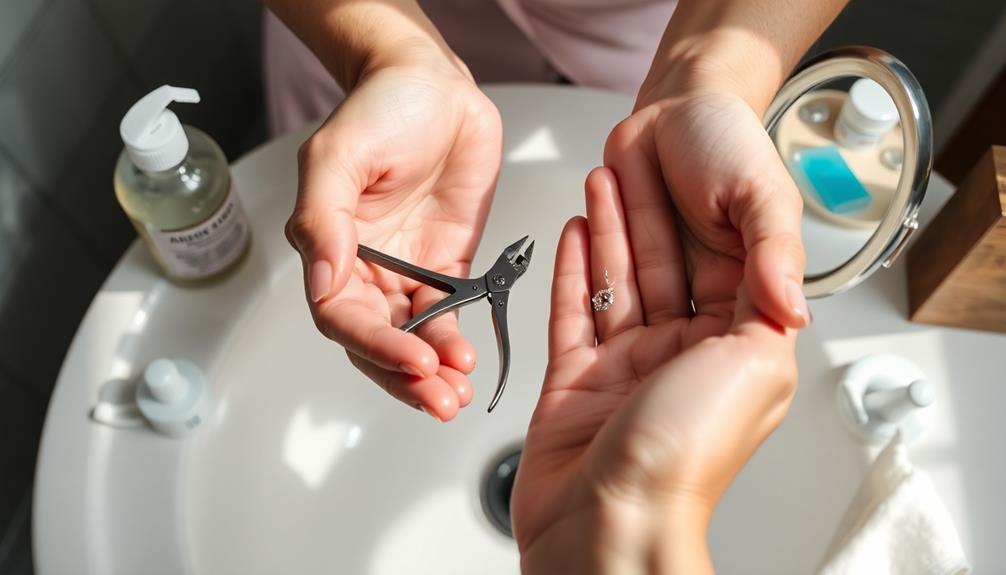
Before you change your piercing jewelry, make sure your piercing is fully healed and your hands and jewelry are clean.
Next, you'll use proper techniques to safely remove the old jewelry and insert the new piece.
Following these steps carefully will help you avoid irritation or complications during the process.
Preparation and Safety Tips
Changing your piercing jewelry at home can be a straightforward process if you're well-prepared and follow safety tips. Before diving in, it's essential to verify your piercing is fully healed. This helps prevent irritation or complications during the change.
Here are some essential preparation and safety tips to keep in mind:
- Clean your hands and jewelry using piercing soap.
- Consider wearing nitrile gloves for improved grip and hygiene.
- Prepare your workspace by placing a towel in the sink to catch any dropped pieces.
- Stop if you encounter resistance or discomfort; consult a professional instead.
Effective cleaning is key to maintaining hygiene throughout the process. Make certain your chosen jewelry is also clean before you start.
When it comes to technique, familiarize yourself with the specific type of jewelry you're changing; for example, twist the rod counterclockwise to loosen balls from labrets and barbells.
Proper preparation and technique will help you navigate the change smoothly. Remember, if anything feels off, don't hesitate to reach out to a professional. Your safety and the health of your piercing should always come first.
Jewelry Change Techniques
Once you're prepared and ready to go, it's time to tackle the jewelry change process step-by-step. First, check that your piercing is fully healed; look for any redness or swelling.
Clean your hands and the jewelry using piercing soap, and wear nitrile gloves for better grip and cleanliness.
For threaded jewelry, remember the rule "righty tighty, lefty loosey." Securely hold the flatback post while unscrewing or screwing on the decorative piece.
If you're changing segment rings, gently twist the ends apart. For rings with a closure that clicks, locate the hinge and click it open—avoid pulling the ends apart to prevent deformation.
Once you've inserted the new jewelry, inspect it for a proper fit. Confirm it feels comfortable and adjust as necessary to avoid irritation.
If everything looks good, you've successfully changed your piercing jewelry! Just remember to keep your hands clean and handle the jewelry carefully to maintain its quality.
With practice, this process will become easier, allowing you to confidently switch your jewelry whenever you like.
Tips for Specific Jewelry Styles
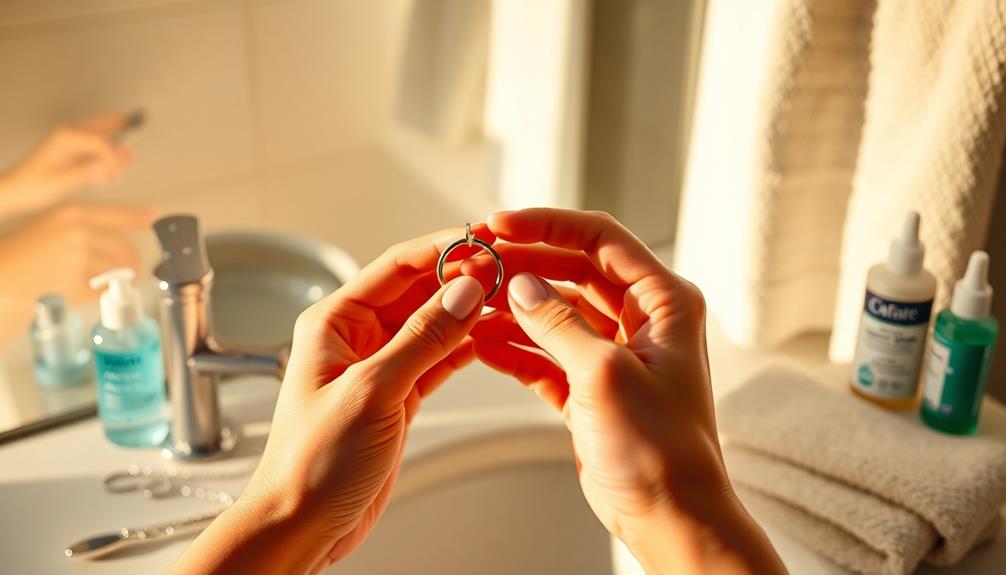
When it comes to changing your piercing jewelry, each style has its own set of unique characteristics and techniques. Knowing how to handle different types can make the process smoother and safer.
- Screw-in studs require you to hold the flatback post steady while unscrewing the top to the left. Check for tightness regularly to prevent loosening.
- For segment rings, gently bend the ends sideways to open the ring, avoiding pulling them apart. Bend them back securely after replacing your jewelry.
- When dealing with click rings, open them by gently pulling the ends apart. Verify a proper fit by pushing the ends together until you hear a click.
- With labrets and barbells, securely hold the piercing rod with one hand while loosening the ball by twisting counterclockwise with the other hand to protect the threads.
Care and Maintenance Practices
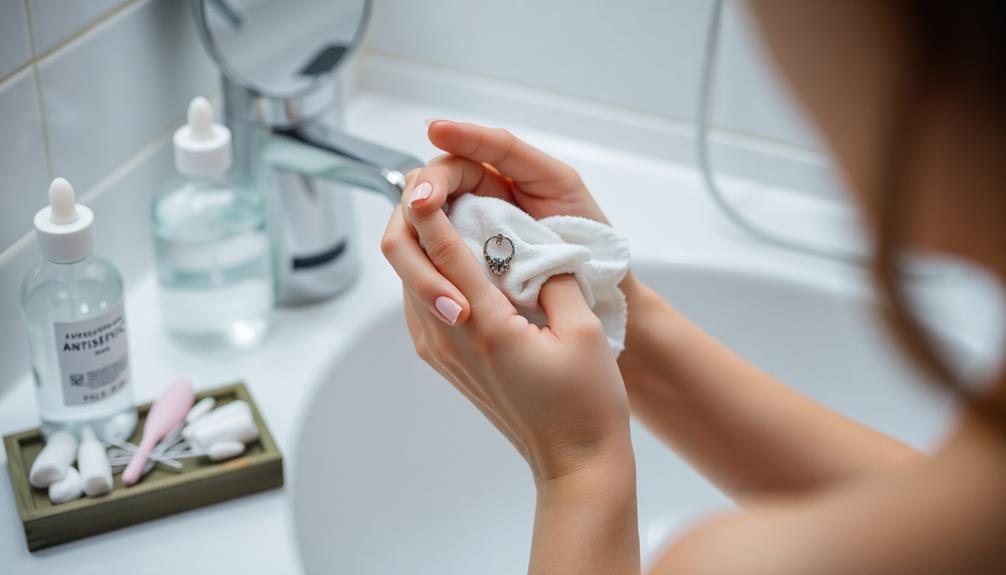
Consistently caring for your piercing jewelry is vital to guarantee its longevity and your health. Start by regularly cleaning your jewelry with a saline solution or antiseptic wipes. This practice helps prevent infections and maintains proper hygiene.
Make it a habit to inspect your jewelry for signs of wear, like scratches or loose components. Addressing these issues early can avoid complications while you wear it.
Storage is equally important. Keep your jewelry in a clean, dry place, away from moisture and harsh chemicals to prevent tarnishing and damage. Adhering to aftercare instructions specific to your piercing type is fundamental for proper healing and making sure the jewelry lasts.
Additionally, consider moisturizing your piercing with suitable ointments as recommended, but be careful to avoid harsh chemicals that could irritate your skin.
Shopping for Piercing Jewelry
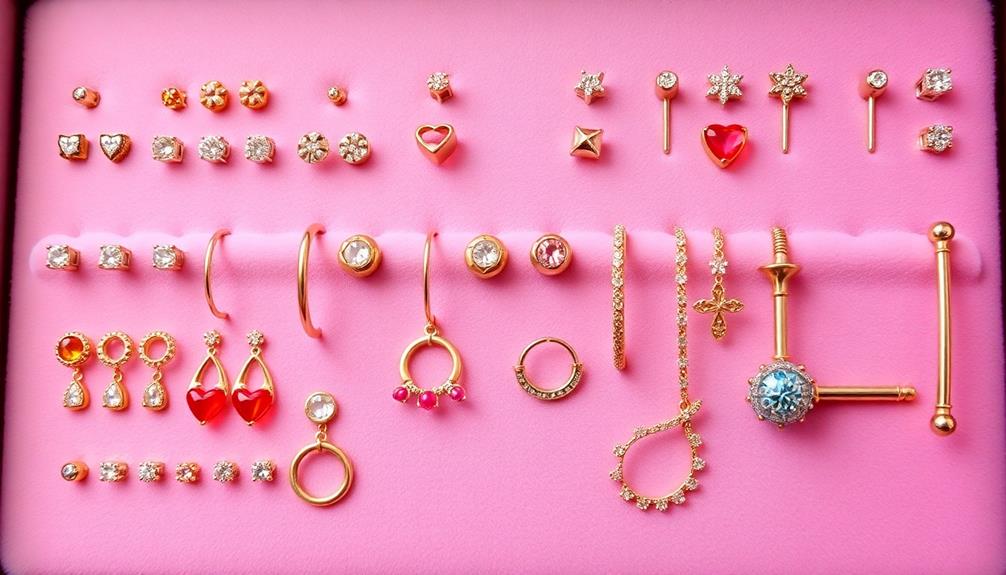
Maintaining your piercing jewelry is just part of the journey; knowing how to shop for the right pieces is equally important. When you're changing body jewelry, you want to make certain you're making informed choices. Here are some key things to take into account:
- Choose high-quality materials like surgical steel, titanium, or solid gold.
- Match your jewelry's gauge size, diameter, and length to your piercing.
- Look for retailers offering free shipping on orders over $75.
- Take advantage of promotional offers, like "Shop Sets & save up to $40."
Shopping for piercing jewelry can be overwhelming, but focusing on quality is vital. High-quality materials are hypoallergenic and safe for sensitive skin, which helps prevent irritation.
You'll also want to guarantee the jewelry fits properly, as the wrong size can lead to discomfort and complications.
Remember to distinguish between piercing jewelry and fashion jewelry; the former is designed for healing and comfort.
Troubleshooting Common Issues
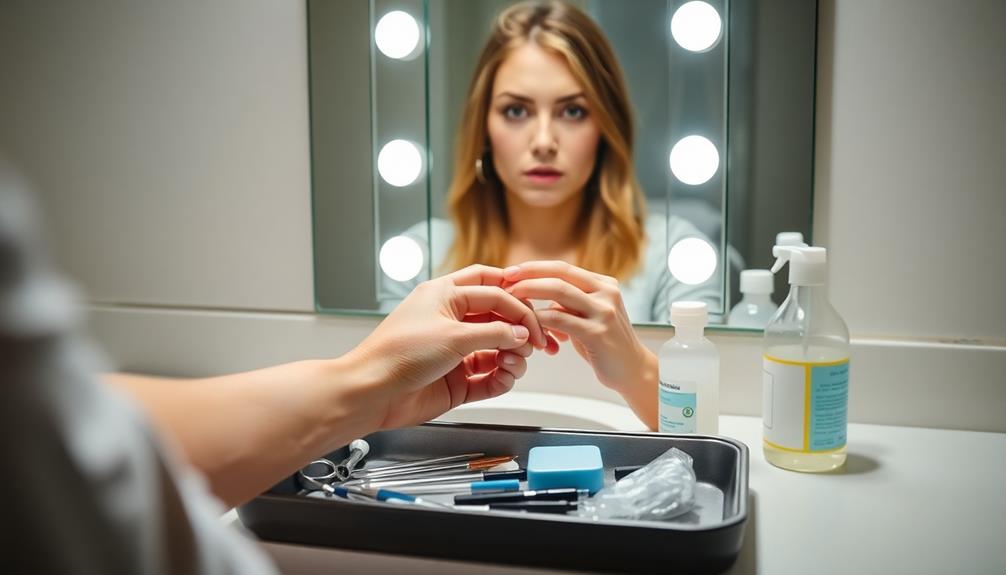
When changing your piercing jewelry, you might run into sizing issues or experience irritation.
If the new piece feels too tight or causes discomfort, check the gauge size and consider a lubricant for easier insertion.
Jewelry Sizing Problems
Changing piercing jewelry at home can sometimes lead to sizing problems that frustrate the process. To avoid complications, keep the following in mind:
- Know the gauge size of your existing jewelry, as even a one gauge difference can make changing jewelry difficult.
- Verify your new jewelry's diameter and length measurements align with your piercing.
- Be cautious with new materials; surgical steel, titanium, and solid gold are generally safer for sensitive skin.
- Inspect your jewelry regularly for wear and tear, as damaged pieces can exacerbate sizing issues.
If the new jewelry feels too tight or too loose, double-check those diameter and length measurements.
When inserting the jewelry, if you encounter resistance, don't force it; this can cause trauma. Instead, consider using a lubricant like Holey Buttr for easier insertion.
Lastly, if you experience persistent sizing problems, revisit your jewelry's gauge size, diameter, and length measurements.
Irritation After Changing
Irritation can often arise after you change your piercing jewelry, and addressing it promptly is vital for your comfort and healing.
First, check if the new piece is made from hypoallergenic materials, like surgical steel or titanium. These materials help minimize allergic reactions that can lead to irritation.
Keep an eye out for symptoms such as redness, swelling, or discharge. If these signs persist, consult a professional piercer for advice.
It's also important to avoid changing your jewelry too frequently during the healing process, as this can worsen irritation and prolong your healing time.
To soothe irritation and prevent infection, clean the area around the piercing with a saline solution or antiseptic wipes. This simple step can greatly reduce the risk of complications.
If discomfort continues despite your efforts, consider reverting to your original jewelry until the irritation subsides. This pause allows the piercing to heal properly and helps guarantee a smoother change when you decide to change jewelry again.
Taking these steps can help you maintain healthy piercings and enjoy your new jewelry without unnecessary irritation.
Techniques for Difficult Pieces
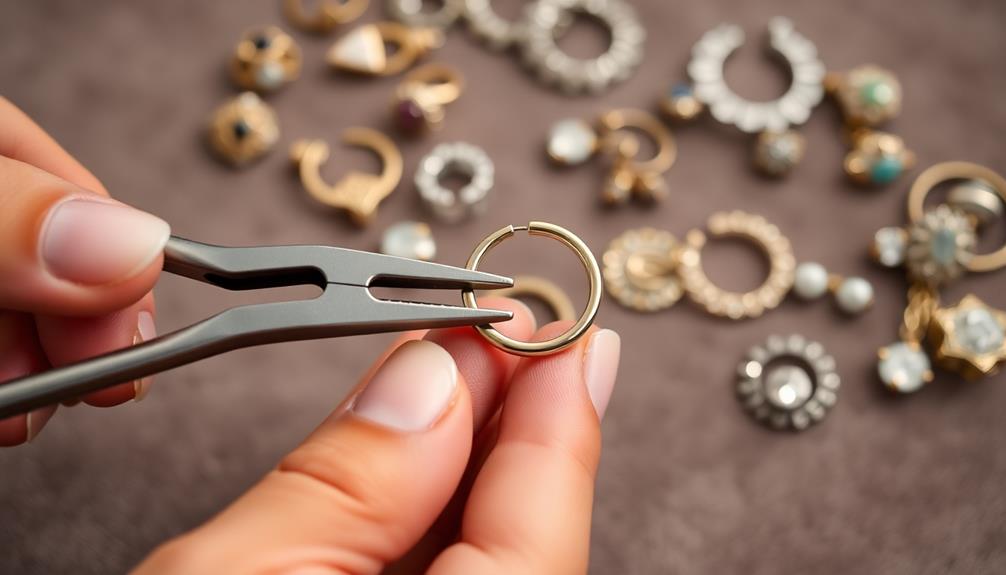
Some piercing jewelry can be tricky to change, especially pieces like captive bead rings and segment rings. To make the process smoother, try these techniques:
- Gently twist the earring sides of captive bead rings in opposite directions to avoid damaging the ring's shape.
- Use a bead holder tool when threading beads onto septum jewelry for a secure grip.
- When changing threaded jewelry, hold the flatback post in place while unscrewing the top to the left to prevent stripping the threads.
- For hinged segment rings, use a string or hair band to easily open the hinge while ensuring the ends remain intact.
When dealing with seamless rings, locate the hinge and click it out carefully to avoid deformation.
Once you've changed your jewelry, remember to close it securely to maintain its integrity.
By using these techniques, you'll be better prepared to tackle those difficult pieces of piercing jewelry without frustration.
Just take your time, and don't rush the process.
With practice, changing your jewelry will become easier, and you'll gain confidence in handling even the trickiest of pieces.
Resources for Further Assistance
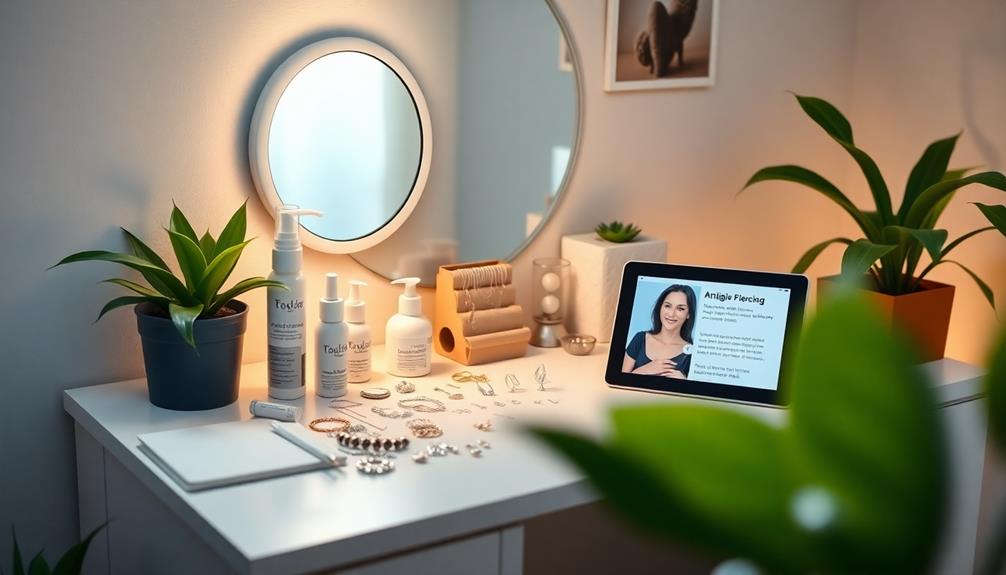
If you find yourself struggling with changing your piercing jewelry, you're not alone. Many people face challenges during this process. Luckily, there are plenty of resources available for you. For professional assistance, consider booking a service at a reputable piercing studio. They'll guarantee safety and proper technique.
If you encounter uncertainties, don't hesitate to reach out directly to your piercing studio. Their staff can provide guidance and support tailored to your specific situation. Additionally, a wealth of online articles can help you navigate the jewelry changing process. These resources cover everything from definitions and care tips to step-by-step guides.
Here's a quick overview of where to find help:
| Type of Resource | Description | Contact Method |
|---|---|---|
| Professional Studios | In-person assistance for safe changes | Phone or Visit |
| Online Articles | Step-by-step guides and care tips | Website Access |
| Customer Service | Personalized help for your specific questions | |
| Trend Articles | Stay informed about popular styles | Blog or Magazine Access |
| Community Forums | Peer support and shared experiences | Online Platforms |
Utilizing these resources will empower you to change your jewelry confidently.
Frequently Asked Questions
Is It Safe to Change Your Own Piercing?
Yes, it's safe to change your own piercing as long as it's fully healed. Just remember to wash your hands and jewelry, use high-quality materials, and check for irritation before you start.
How Do You Sterilize New Jewelry at Home?
To sterilize new jewelry at home, soak it in 70% isopropyl alcohol for 10-15 minutes, boil it for 5-10 minutes, or use a UV sterilizer. Always rinse with sterile saline afterward. Store it in a sealed container.
Will Piercers Change Jewelry for Free?
You've probably wondered if you can get your jewelry changed for free. Many piercers do offer this service, especially for jewelry purchased at their studio. Just check your local shop's policy to be sure.
How Do You Remove Starter Earrings?
To remove starter earrings, grasp both ends firmly. For push-pin styles, hold the post steady while twisting out the decorative piece. For screw types, unscrew the top to the left. Always keep everything clean!
Conclusion
Changing your piercing jewelry at home can feel intimidating, but with the right preparation and care, it's totally manageable. If you're worried about infection, remember that keeping your hands clean and using sterilized tools makes a huge difference. Trust your instincts, take your time, and don't hesitate to ask for help if you need it. By following these guidelines, you can safely and confidently update your look without any stress. Enjoy your new style!
Hi, my name is Danielle, and I’m an author for piercings-body.com. I have a passion for writing and love to share my knowledge on all things body piercing-related. I’m also a huge advocate for safe body modification practices and believe everyone should be able to make informed decisions about their bodies. When I’m not writing or blogging, I enjoy spending time with my family and friends, practicing yoga, and exploring new places.

